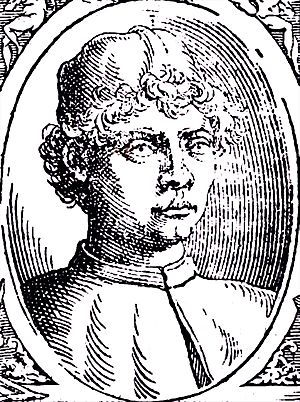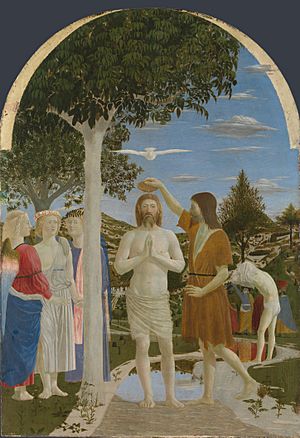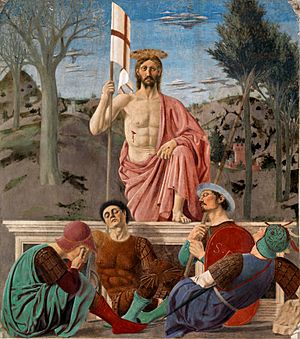Piero della Francesca facts for kids
Quick facts for kids
Piero della Francesca
|
|
|---|---|
 |
|
| Born | 1415 Sansepolcro, Republic of Florence
|
| Died | 12 October 1492 (aged 77) Sansepolcro, Republic of Florence
|
| Nationality | Italian |
| Known for | Painting, Fresco |
|
Notable work
|
The Baptism of Christ Flagellation of Christ Brera Madonna |
| Movement | Early Renaissance |
Piero della Francesca (born around 1415 – died October 12, 1492) was a famous Italian painter. He lived during the Early Renaissance period. His original name was Piero di Benedetto.
Besides being a great artist, Piero was also known as a talented mathematician and geometer. Today, people mostly remember him for his amazing art. His paintings are special because they show a calm and thoughtful style, using lots of geometric shapes and perspective (making things look 3D on a flat surface). His most famous artwork is a series of wall paintings called The History of the True Cross. You can find these in the San Francesco church in Arezzo, a town in Italy.
Contents
Biography
Early Life and Training
Piero was born in a town called Borgo Santo Sepolcro, which is now known as Sansepolcro in Tuscany, Italy. His father, Benedetto de' Franceschi, was a merchant. His mother was Romana di Perino da Monterchi. Piero's father passed away before he was born. Because of this, Piero was named after his mother, "della Francesca" meaning "of Francesca." His mother made sure he got an education in both math and art.
Piero likely started learning art from a local painter named Antonio di Giovanni d'Anghiari. Records show he worked with Antonio in the 1430s. He also saw the work of artists from Siena who were active in his hometown. In 1439, Piero worked on frescoes (wall paintings) in Florence with another artist, Domenico Veneziano. These paintings are now lost.
While in Florence, Piero probably met other important artists. These included Fra Angelico, Luca della Robbia, Donatello, and Brunelleschi. He was especially inspired by the frescoes of Masaccio in the Santa Maria del Carmine church. Masaccio's paintings had grand, powerful figures. It's hard to put exact dates on Piero's early works because his painting style didn't change much over the years.
Growing as an Artist
Piero went back to his hometown in 1442. He was even chosen to be on the City Council of Sansepolcro. Three years later, he got his first big job. He was asked to paint the Madonna della Misericordia for the Misericordia church. He finished this large artwork in the early 1460s.
Around 1449, he painted more frescoes in Ferrara, but these are also lost today. His style had a strong impact on later artists from Ferrara, like Cosimo Tura.
One of his famous works, The Baptism of Christ, was finished around 1450. It was made for a church in Sansepolcro and is now in the National Gallery in London. Other important works include The Resurrection in Sansepolcro. Also, the Madonna del parto in Monterchi is well-known.
In 1451, Piero worked for a military leader named Sigismondo Pandolfo Malatesta in Rimini. There, he painted a famous fresco of St. Sigismund and Sigismondo Pandolfo Malatesta. He also painted a portrait of Sigismondo. In Rimini, Piero might have met Leon Battista Alberti. Alberti was a famous architect and mathematician of the Renaissance. After Rimini, Piero also worked in other Italian cities like Ancona, Pesaro, and Bologna.
In 1454, Piero signed a contract for a large painting called the Polyptych of Saint Augustine. This artwork was for a church in Sansepolcro. The main part of this painting is now missing. The other parts, showing different saints, are spread out in museums around the world. A few years later, Pope Nicholas V asked him to paint frescoes in Rome. Only small pieces of these paintings in the Basilica di Santa Maria Maggiore remain. He also painted in the Vatican Palace, but those paintings have been destroyed.
The Arezzo Frescoes
In 1452, Piero della Francesca was asked to work in Arezzo. He took over painting the frescoes in the basilica of San Francesco, Arezzo. He finished this important work in 1464.
The series of frescoes called The History of the True Cross is considered one of his greatest achievements. It's also seen as one of the best examples of Renaissance painting. These paintings tell a legendary story. It's about how pieces of the True Cross (the cross Jesus was crucified on) were found. These stories come from a famous medieval book called Golden Legend.
Working in Urbino
Piero was invited to the city of Urbino by Giovanni Santi. From 1469 to 1486, Piero worked often for Count Federico III da Montefeltro. Federico later became a Duke. The Flagellation is thought to be one of Piero's earliest works in Urbino (around 1455–1470). It's one of the most famous and debated paintings from the early Renaissance. It looks very orderly and geometric. It also has a mystery about the three men standing in the front.
Another famous painting from Urbino is the Double Portrait of Federico and his wife, Battista Sforza. This painting is in the Uffizi gallery. The portraits show them from the side, like old medals. Other paintings made in Urbino include the large Montefeltro Altarpiece (1474). This is in the Brera Gallery in Milan. The Madonna of Senigallia was probably also painted there.
In Urbino, Piero met other artists like Melozzo da Forlì and Justus van Gent. He also met the mathematician Luca Pacioli and the architect Francesco di Giorgio Martini. He likely met Leon Battista Alberti there too.
Later Years and Legacy
In his later years, other painters like Perugino and Luca Signorelli often visited Piero's workshop. He finished a book about perspective in painting, called On Perspective in painting, between the mid-1470s and 1480s. By 1480, his eyesight started to get worse. But he kept writing books, like Short Book on the Five Regular Solids in 1485.
Piero rented a house in Rimini in 1482. He made his will in 1487. He passed away five years later, on October 12, 1492, in his home in Sansepolcro. He left his belongings to his family and the church. Interestingly, he died on the same day that Christopher Columbus arrived in the Americas.
Math and Geometry in His Art
Piero was very interested in the theory of perspective. This deep interest and his thoughtful way of painting are clear in all his artworks.
When he was young, Piero learned mathematics. This was probably to help him with trade. Three of Piero's books on math have survived. These are Trattato d'Abaco (Abacus Treatise), Libellus de Quinque Corporibus Regularibus (Short Book on the Five Regular Solids), and De Prospectiva pingendi (On Perspective in painting). These books cover topics like arithmetic, algebra, geometry, and new ideas in solid geometry and perspective.
Much of Piero's math work was later used by others, especially Luca Pacioli. Piero's ideas on solid geometry were included in Pacioli's book Divina proportione. This book had illustrations by Leonardo da Vinci. People who wrote about Piero's patron, Federico da Montefeltro of Urbino, said that the Duke encouraged Piero's interest in perspective.
In the late 1450s, Piero copied and illustrated several works by the ancient Greek mathematician Archimedes. These included books like On the Sphere and Cylinder and Measurement of a Circle. The handwritten copy, with 82 pages, is now in the Biblioteca Riccardiana. It's a copy of a translation made by an Italian scholar named Iacopo da San Cassiano.
Inspirations from Piero
Piero's precise geometry and the almost magical light in his paintings have inspired many modern artists. These include painters like Giorgio de Chirico and Balthus.
The composer Bohuslav Martinů wrote a three-part musical piece for orchestra. It's called Les Fresques de Piero della Francesca (The Frescoes of Piero della Francesca). It was first performed in 1956.

Images for kids
See also
 In Spanish: Piero della Francesca para niños
In Spanish: Piero della Francesca para niños






